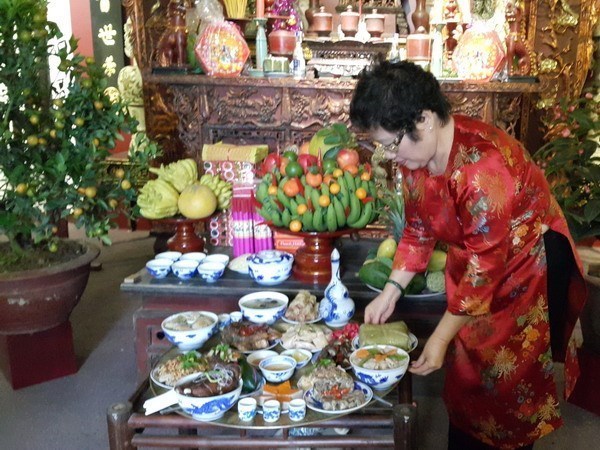Popular Lunar New Year traditions in Vietnam
The festival which best epitomises Vietnam's cultural identity is the Lunar New Year or Tet, with a lot of meaningful customs and traditional special foods.
The festival which best epitomises Vietnam's cultural identity is the Lunar New Year or Tet, with a lot of meaningful customs and traditional special foods.
“Tet” is the phonetic deformation of "Tiet", a Sino-Vietnamese term which means "Joint of a bamboo stern" and in a wider sense, the "beginning of a period of the year". The passage from one period to the next may cause a meteorological disturbance (heat, rain, mist) that must be exercised by ritual sacrifices and festivities. There are many Tets throughout the year (Mid-Autumn Festival, Cold Food Festival, etc.). But the most significant of all is "Vietnamese New Year", which marks the Lunar New Year.
For the Vietnamese people, the Lunar New Year is like a combination of Western Saint Sylvester, New Year's Day, Christmas, Easter and Thanksgiving. It is a festival of purity and renewal.
1. Cleaning and decorating homes
Homes are often cleaned and decorated before New Year's Eve. Children are in charge of sweeping and scrubbing the floor. The kitchen needs to be cleaned before the 23rd day of the last lunar month. Usually, the head of a family cleans the dust and ashes (from incense) from the ancestral altar. It is a common belief that cleaning the house will get rid of the bad fortunes associated with the old year. Some people would paint their house and decorate with festive items.
2. Getting new clothes
This is often the most exciting part of the Lunar New Year among children. Parents usually purchase new clothes and shoes for their children a month prior to the festival. However, children cannot wear their new clothes until the first day of Tet and onward. The best outfit is always worn on the first day of the year.
3. Farewell ceremony for the Kitchen Gods (Ong Tao)
Seven days (the 23rd day of the last lunar month) prior to Tet, each Vietnamese family offers a farewell ceremony for “Ong Tao” (Kitchen Gods) to go up to the Heaven Palace. Their task is to make an annual report to the Jade Emperor on the family's affairs throughout the year.
4. Giao thua (Lunar New Year's Eve)
However, in a literal translation, it means "Passage from the Old to the New Year". It is a common belief among Vietnamese people that there are 12 sacred animals from the zodiac taking turn monitoring and controlling the affairs of the earth. Thus, Giao thua (New Year's Eve) is the moment of seeing the old chief end his ruling term and pass his power to the new chief. “Giao thua” is also the time for Ong Tao (Kitchen Gods) to return to the earth after making the report to the Jade Emperor. Every single family should offer an open-air ceremony to welcome him back to their kitchen.
5. Xong dat (Aura of the Earth)
“Giao thua” is the most sacred time of the year. Therefore, the first houseguest to offer the first greetings is very important. If that particular guest has a good aura (well respected, well educated, successful, famous, etc.), then the family believes that they will receive luck and good fortune throughout the year. The belief of “xong dat” still remains nowadays, especially among families doing businesses.
6. Hoa mai and hoa dao (apricot and peach flowers)
Flower buds and blossoms are the symbols for new beginning. These two distinctive flowers are widely sold and purchased for Tet. “Hoa mai” are the yellow apricot flowers often seen in the south. They are more adaptable to the hot weather of the southern region, thus, it is known as the primary flower in every home there. “Hoa dao” are the warm pink of the peach blossoms that match well with the dry, cold weather in the north. Tet is not Tet if there is no sight of “hoa mai” (south) or “hoa dao” (north) in every home.
7. Giving away lucky money in red envelopes
This is a cultural practice that has been maintained for generations. Red envelopes symbolise luck and wealth. It is very common to see older people giving away red envelopes with lucky money inside to the younger. The older ones would return good advice and words of wisdom, encouraging the young to keep up with the schoolwork, live harmoniously with others, and obey their parents. This greeting ritual is known as “mung tuoi”, honouring the achievement of another year to one's life.
8. Making offerings for ancestors
This ceremony is held on the first day of the New Year before noontime. The head of a family should perform the proper ritual (offering food, wine, cakes, fruits, and burn incense) to invite the souls of the ancestors to join the celebration with the family. This is the time families pay tribute to their ancestors and pray for welfare.
9. Traditional special foods
One of the most traditional special foods for Tet is “banh chung” or square glutinous rice cake. “Banh chung” is made of sticky rice, pork, and mung bean wrapped inside a special leaf called “dong” and boiled for about 12 hours. Making “banh chung” requires care and precision in every step. The rice and green bean has to be soaked in water for a day to make it stickier. The pork is usually seasoned with pepper for several hours. Squaring off and tying the cakes with bamboo strings require skillful hands to make it a perfect square. “Banh chung” is a must among other foods to be placed on the ancestors’ altars during Tet./.











